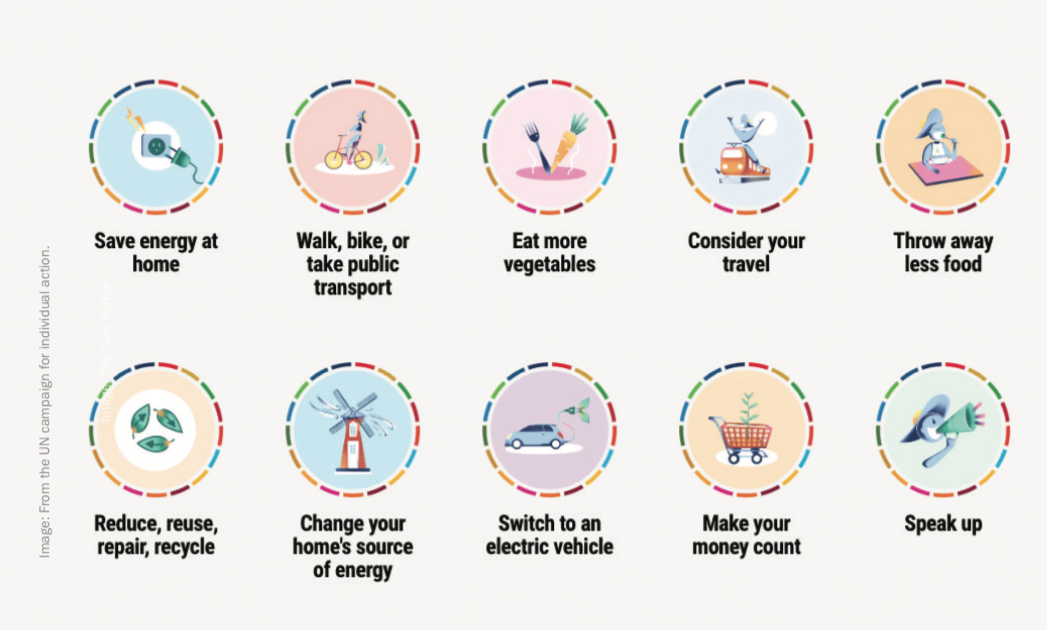We keep doing what we do, because we have no clue of the actual consequences of our everyday life. We think we know but we don’t. Do our actions and habits make life easier or harder? ‘Tough times create strong men, strong men create easy times, easy times create weak men, and weak men create tough times.’ These are lines from a post apocalyptic novel by G. Michael Hopf. Annotating these lines Aaron Mckie, a former professional basketball player and an American basketball coach, talks about a conversation he had with his friend about the future of their kids; his friend said, ‘My grandfather walked ten miles to work everyday, my father walked five, I’m driving a Cadillac, my son is in a Mercedes, and my grandson will be in a Ferrari. My great-grandson will be walking again.’ There are crucial lessons here for all of us.
The climate lesson is this, my grandfather lived in want; my father grew vegetables, did not waste food, recycled and reused whatever possible; I take the planet for granted, use up fossil fuel, waste food, make maximum profit, and I don’t speak up about climate change; my son lives entitled, use and throw is the theory, discounts climate change; and my grandson will be drunk with power and pride like Icarus, and abuse the resources of the planet. My great-grandson will be in want again.
Are we racing towards a climate catastrophe? At this juncture of our life on this planet earth, the Icarus story from the Greek mythology perhaps be worth remembering. Icarus was a minor character in Greek Mythology, famous for not surviving the transition from boyhood to manhood. He was the son of Daedalus, an accomplished inventor, who produced an ingenious labyrinth. Even Daedalus could not find a way out of his maze. Because he was his father’s son, Icarus faced the same fate. Daedalus built wings of feathers and wax to escape. In theory, the wings would al- low Daedalus and Icarus to fly above the labyrinth and off the island to freedom. Just before their flight, Daedalus warned his son to be careful. If he flew too low, his wings would get wet in the ocean; if he flew too high, the sun would melt the wax and the wings would disintegrate. Icarus took off with all intentions of following his father’s sage advice. Away they flew, escaping the labyrinth. Now that he could fly he grew in false prowess. Drunk with his newfound power, he soared higher in the sky, intending to reach the sun. Soon enough his waxwings got melted and he fell to his death. As the inhabitants of this earth, the earth, the ecosystem is our wings to fly, would we melt it with our own greed, mindlessness, and stupidity; and fall victim to a catastrophe? The call is to move from the madness of more to the wisdom of enough.
Climate Change Is Real and It Affects the Poor the Most
The rate and duration of warming observed during the twentieth century are unprecedented in the past thousand years. Increases in maximum temperatures, numbers of hot days, and the heat index have been observed over nearly all countries during the second half of the twentieth century. Poverty and Climate Change, A joint report by United Nations, The World Bank and other international agencies, categorically point out that extreme events have increased in Asia, including floods, droughts, forest fires, and tropical cyclones. Reduced soil moisture in the summer may increase land degradation and desertification. Sea level rise and an increase in intensity of tropical cyclones would displace tens of millions of people in low-lying coastal areas of tropical Asia. The capacity to cope with climate variability and extreme weather events in itself is highly dependent on the level of economic development. Its adverse impacts will be most striking in the developing nations because of their geographical and climatic conditions, their high dependence on natural resources, and their limited capacity to adapt to a changing climate. Within these countries, the poorest, who have the least resources and the least capacity to adapt, are the most vulnerable. Projected changes in the occurrence, frequency, intensity, and duration of climate extremes (for example, heat waves, heavy rainfall, and drought), as well as more gradual changes in the average climate, will notably threaten the poorest of the poor the most.
Climate Action Now
Climate change is of human making; we must explore ways to battle it. If the emissions have to stop, then we must stop the emissions, says, Greta Thunberg, the Swedish child environmental activist who is known for challenging world leaders to take immediate action for climate change mitigation. She refused to go to school as a protest. She boycotted school and went and sat in demonstration in front of the Swedish parliament. She persuaded her parents to adopt lifestyle choices that reduced their own carbon footprint. We must also do our bit to protect and safeguard our planet, for we do not have a planet B. It is important to hope for better days for our planet; but what is more urgent is action. Fifth of June is the World Environment Day. Environment Day 2023 is being hosted by Ivory Coast with the theme ‘living sustainably in harmony with nature.’ If we begin to act towards climate empowerment, hope for us and for the planet will emerge as a consequence.
Written as TOGETHER editorial.

Comments
Post a Comment